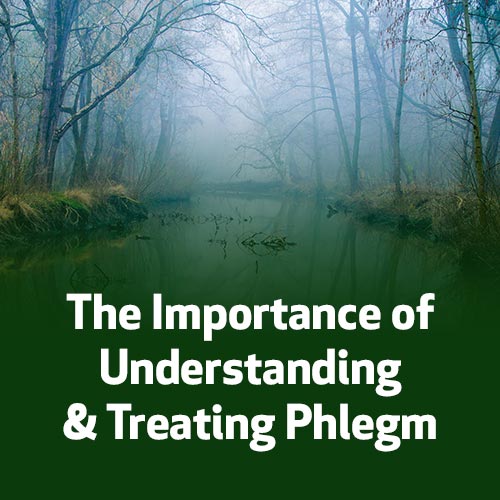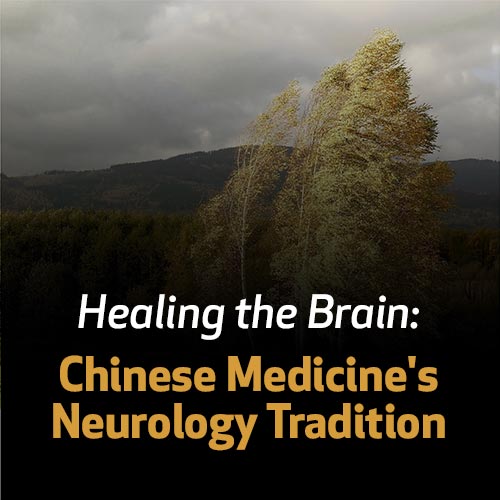Healing the Brain: Chinese Medicine’s Neurology Tradition
In the long history of Chinese Medicine, many traditions have developed that emphasize different diagnostic and treatment perspectives. In my clinical experience, one of the most interesting and effective is the Wai Ke.
Primarily understood as a practice of external medicine, it is a well-developed dermatology tradition able to treat an extensive range of skin conditions. Less well-known but equally important is that the Wai Ke tradition is also very effective in treating neurological conditions of all kinds. And the connection between the dermatological and neurological is the diagnosis of wind.
While the emphasis is on external wind with dermatology, with neurological conditions, the focus is on wind internally. And while there are other issues connected to conditions affecting the brain, having a place to start—namely looking for wind—can clarify the diagnosis and treatment process.
The Wai Ke tradition also includes many insightful ideas on addressing both root and branch issues. One is that internal wind—which causes symptoms like tremors, twitches, seizures, and migraines—can originate from external wind. In other words, a wind-heat or wind-cold condition that starts on the surface can progress internally and create chronic neurological symptoms. From this view, the effective diagnosis and treating of superficial pernicious influences is a way to prevent more significant neurological conditions.
Another important idea is that with neurological symptoms being associated with wind, in addition to treating the wind itself, it’s important to understand deeper underlying issues. Using the Wu Xing/Five Phase tradition as a lens, we can see how the wind associated with the Wood phase can come from issues in the Water. Looking at the Sheng Cycle relationship between the two, the overstimulation that is internal wind, can be affected by a deficiency in the Water. Specifically, a lack of Kidney Yin can result in excess in the Liver because if the Kidney is dry, this lack of fluids can create blood deficiency. And as part of the nature of blood is to relax the tendons and ligaments, when there is a lack of this softening influence, tremors and twitches can occur.
Along with Yin deficiency in Water contributing to an excess in the Wood, a lack of Qi in the Kidney can also contribute to internal wind. Another part of the relationship between the two phases is that the Kidney provides a downward root to the upward-rising nature of the Liver. If the Kidney Qi is deficient, the Liver can become excess, again creating internal wind.
Another interesting and, in my experience, very important understanding in treating wind comes from the disease progression theory of Bian Hua/To Change and Transform. It describes how internal wind can be part of a process, where one imbalance can create others. The four parts of the progression start’s with some basic Chinese medicine theory as the first stage of heat creates the second stage of dryness. This lack of fluid creates the third stage of phlegm. This excess of fluids occurs when the body compensates for the lack of healthy Yin by creating or holding on to pathological Yin in the form of dampness.
Because of the nature of phlegm, which often creates stagnation, the body can respond by trying to promote movement through generating internal wind, the fourth stage of the progression. This dynamic of a lack of movement—coming from the stagnation from phlegm--creating an excess of movement—which is internal wind-- can describe the creation of the diagnosis where these two conditions become one dynamic in wind phlegm. And what Bian Hua can also show is that this wind phlegm can come from heat and dryness.
In my clinical experience, the reaction of heat, dryness, and phlegm creating internal wind can have real-world clinical significance in sometimes treating hard to address neurological conditions. Based on both pulse and tongue diagnosis and signs and symptoms, many patients I treat with the migraines and vertigo associated with late-stage Lyme and the tremors and twitches of Parkinson’s have part or all of the four-stage progression. This can indicate that to effectively treat the neurological overstimulation that is the internal wind, other parts of the progression will likely need to be addressed. In other words, heat, dryness, and phlegm may need to be treated specifically if internal wind and the associated symptoms are to be resolved effectively.
Other Courses By This Teacher






COVID and Climate Crisis: Personal and Ecological Healing
with Brendan Kelly
Overview
Embedded in the long history of Chinese medicine is the understanding that we are intimately connected to the world around us. Using contemporary western climate science and a traditional Chinese medicine understanding of epidemics, we'll discuss the direct, immediate connection between COVID and the destabilization of the climate. Brendan also uses the ideas and research from his book “The Yin and Yang of Climate Crisis” to discuss the bigger and deeper issues connected to our warming planet including imbalances in our economic and medical systems as well as what we value individually.
We’ll also use the lens of the Chinese medicine's School of Heat/Wen Bing tradition--which was developed starting in the 1300s in response to other epidemics— to provide a larger, cultural view of the underlying conditions that contribute to creating wide-spread sickness and disease. Brendan will also discuss his clinical experience using western and eastern herbs to treat Chinese medicine's understanding of COVID and other viral infections.
Learning Objectives
- Understand the connection between the deeper root issues that create the indivdual and societal conditions for COVID and climate change.
- Understand the use of eastern and western herbs to treat a Chinese medicine understanding of COVID.
- Understand a Chinese medicine view of COVID and other viral infections based on the principles from the School of Cold/Shang Hun Lun.
- Understand the basics of western climate science.
- Understand a Chinese medicine view of the development of epidemics based on principles from the School of Heat/ Wen Bing tradition.
Your Teacher

Brendan Kelly
Brendan Kelly LAc is an acupuncturist, herbalist, author and professor who has been practicing Chinese medicine full-time since 2004. His first book “The Yin and Yang of Climate Crisis” uses the lens of Chinese medicine to look at the bigger and deeper issues of global warming.
Categories
Tags
Overview
Part of the brilliance and deep reaching clinical efficacy of Chinese medicine is its ability to make seemingly difficult and confusing conditions clear and accessible. One example is the understanding of the different origins of tan/phlegm.
In our modern discussion, we often understand phlegm as coming from pathology of the Spleen as it is associated with the Earth phase and the climatic influence of dampness. And while the Earth can be a cause of dampness all Five Phases can also be involved and there are seven different types of phlegm. Interestingly,. in the long history of Chinese medicine there is no major tradition that emphasizes phlegm as the root cause of disease. In other words, it’s understood that phlegm is a branch issue that is responding to other deeper pathology.
We'll also discuss tan/phlegm as part of many seemingly difficult to address conditions where treatments are not responding, there's improvement but not complete healing, there's constant depression and lethargy and where there's pulse discrepancies and imbalances in the left and right pulses and differences in pulses in the three jiaos.
Brendan will also present an indpeth case study of treating a patient with long-term, late-stage Lyme with a Five Phase understanding of phlegm using acupuncture, herbs and eastern nutrition.
Learning Objectives
- Understand the potential role of phlegm/tan in addressing a wide range of difficult to treat conditions.
- Understand the nature of tan/phlegm and how it relates to symptoms physically, mentally and emotionally. Included will be an historical discussion of tan.
- Understand the differences between the seven different kinds of phlegm and the importance of differential diagnosis in treating the wide range of phlegm diagnoses.
- Understand how the Wu Xing/Five Phase model can help us understand and treat the underlying causes of phlegm/tan.
- Understand the use of acupuncture, herbal medicine and nutrition in treating the seven different types of phlegm/tan.
Your Teacher

Brendan Kelly
Brendan Kelly LAc is an acupuncturist, herbalist, author and professor who has been practicing Chinese medicine full-time since 2004. His first book “The Yin and Yang of Climate Crisis” uses the lens of Chinese medicine to look at the bigger and deeper issues of global warming.
Categories
Tags
Overview
Using the lens of the School of Cold/Shang Han Lun, we’ll discuss a Chinese medicine understanding of viral infections including COVID19. We’ll look at the progression of viruses and how they can transform into heat/inflammation and effect several organ systems including respiration/Lungs, circulation/Heart, digestion/Stomach and Spleen and cognition through affecting the brain.
Brendan will also discuss his clinical experience treating a Chinese medicine understanding of COVID19 and long-haul COVID with acupuncture, herbs and eastern nutrition.
"Disclaimer: there are no proven treatments for Covid-19”
Learning Objectives
- Have an understanding of the importance of the Shang Han Lun/School of Cold in treating viral infections.
- Have a Chinese medicine based understanding of the nature of most viral infections including COVID-19.
- Have an understanding of the rates of COVID and long COVID in the US and the larger societal issues associated with pandemics. Also have an understanding of the importance of translating the western diagnoses of both conditions into Chinese medicine.
- Have an understanding of the importance of the application of the Wen Bing Xue/School of Heat in treating the inflammation common with viral infections including COVID-19.
- Have an understanding of the importance of integration of different Chinese medicine traditions--specially the Shang Han Lun and Wen Bing Xue-- in treating multi-organ, multi-system conditions including COVID-19.
Your Teacher

Brendan Kelly
Brendan Kelly LAc is an acupuncturist, herbalist, author and professor who has been practicing Chinese medicine full-time since 2004. His first book “The Yin and Yang of Climate Crisis” uses the lens of Chinese medicine to look at the bigger and deeper issues of global warming.
